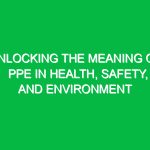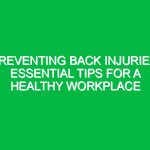Introduction
Personal Protective Equipment (PPE) forms a critical line of defense in the realm of Health, Safety, and Environment (HSE). It encompasses various protective gear designed to shield workers from potential hazards that could cause injury or illness in the workplace. The significance of PPE extends beyond mere compliance with regulations; it is integral to fostering a culture of safety and well-being within organizations. This article delves into the essential strategies for effectively utilizing PPE, exploring its components, benefits, and best practices, while also considering the regulatory frameworks that govern its use. By understanding the importance of PPE within the HSE context, organizations can enhance their safety protocols and create a healthier work environment for all employees.
The Importance of PPE in HSE
PPE is not just a collection of gear; it represents a proactive approach to managing workplace hazards. From construction sites to laboratories, PPE serves to mitigate risks associated with chemical exposure, physical injuries, respiratory issues, and more. According to the Occupational Safety and Health Administration (OSHA), the use of appropriate PPE can significantly reduce the incidence of workplace injuries, thus promoting a safer and more productive workforce.
Moreover, the integration of PPE into HSE strategies reflects an organization’s commitment to protecting its employees. This commitment can enhance employee morale and trust, as workers feel valued and safeguarded against potential dangers. In essence, effective PPE strategies contribute to an overall culture of safety that is vital for sustainable operational success.
Key Components of Effective PPE Strategies
To unlock the full potential of PPE within HSE, organizations must focus on several key components that contribute to effective PPE strategies.
1. Risk Assessment
Before selecting PPE, a comprehensive risk assessment must be conducted. This involves identifying potential hazards in the workplace and evaluating the level of risk associated with each. For instance, in a construction environment, risks may include falling debris, exposure to harmful substances, or electrical hazards. By understanding these risks, organizations can choose appropriate protective equipment tailored to their specific needs.
2. Selection of Appropriate PPE
The selection of PPE is crucial. Not all PPE is created equal, and the effectiveness of protective gear largely depends on its suitability for the identified hazards. Common types of PPE include:
- Head Protection: Hard hats protect against injuries from falling objects.
- Eye and Face Protection: Safety goggles and face shields guard against chemical splashes and flying debris.
- Respiratory Protection: Masks and respirators filter harmful airborne particles.
- Hand Protection: Gloves designed for specific tasks protect against cuts, chemicals, and heat.
- Foot Protection: Steel-toed boots prevent injuries from heavy objects.
Choosing the right PPE involves considering factors such as comfort, fit, and compatibility with other safety equipment. It is essential to engage employees in this process, as their input can lead to higher compliance and effective use.
3. Training and Education
Training is a pivotal aspect of any PPE strategy. Employees must be educated not only on the proper use of PPE but also on its limitations. For example, workers should understand that while gloves may protect against cuts, they may not be suitable for handling chemicals without specific resistance features. Regular training sessions can reinforce the importance of PPE and ensure that employees are aware of new equipment or changes in safety protocols.
Real-life anecdote: A manufacturing company once faced a high rate of hand injuries due to improper glove use. After implementing a comprehensive training program that included hands-on demonstrations and regular refreshers, the injury rate dropped by 40% within six months. This underscores the impact of effective training in promoting PPE compliance and safety.
4. Maintenance and Inspection
PPE requires regular maintenance and inspection to ensure its effectiveness. Damaged or worn-out equipment can provide a false sense of security, leading to increased risks. Organizations should establish a routine for inspecting PPE, including cleaning, repairing, or replacing items as necessary. Keeping records of inspections and maintenance routines can also help track compliance and identify trends in equipment wear.
5. Employee Involvement and Feedback
Encouraging employee involvement in the development and refinement of PPE strategies can yield significant benefits. Workers are often the first to identify issues or suggest improvements based on their daily experiences. Establishing a feedback mechanism allows employees to voice their concerns and contribute to a safer work environment. This participatory approach not only enhances safety but also fosters a sense of ownership and responsibility among employees.
Potential Hazards and Safety Considerations Related to PPE
While PPE is designed to protect, it is essential to acknowledge that improper use can introduce new hazards. For instance, wearing gloves that are not suitable for the task at hand can lead to accidents, such as slips or entanglement in machinery. Additionally, poorly fitting respiratory masks may not seal properly, rendering them ineffective against airborne contaminants. Organizations must emphasize the importance of using PPE correctly and consistently to mitigate these risks.
Furthermore, employees should be made aware of the importance of not over-relying on PPE as the sole safety measure. PPE should be viewed as part of a larger safety system that includes engineering controls, administrative policies, and safe work practices. This holistic approach to safety ensures that workers are protected from multiple angles, reducing the likelihood of accidents and injuries.
Best Practices for Implementing PPE Strategies
Implementing effective PPE strategies requires a structured approach. Here are some best practices to consider:
1. Develop a PPE Policy
Creating a clear PPE policy sets the foundation for all safety practices within the organization. This policy should outline the types of PPE required for various tasks, the responsibilities of employees and supervisors, and the procedures for training, inspection, and maintenance. A well-defined policy ensures consistency and accountability throughout the organization.
2. Conduct Regular Audits
Regular audits help assess the effectiveness of PPE strategies and identify areas for improvement. Audits can involve reviewing training records, inspecting PPE inventory, and gathering feedback from employees. By regularly evaluating the PPE program, organizations can make informed decisions and adjustments to enhance safety measures.
3. Stay Informed About New Regulations
The regulatory landscape surrounding PPE is continually evolving. Organizations must stay informed about new regulations, standards, and best practices to ensure ongoing compliance. Subscribing to industry newsletters, attending safety conferences, and participating in professional organizations can provide valuable insights and updates.
Regulations and Standards Governing PPE
Several regulations and standards govern the use of PPE in various industries. Understanding these regulations is vital for compliance and effective implementation of PPE strategies.
1. OSHA Standards
The Occupational Safety and Health Administration (OSHA) sets forth standards for PPE use in the workplace. OSHA mandates that employers assess hazards and provide appropriate PPE to employees. Specific standards address various types of PPE, such as hearing protection, respiratory protection, and fall protection. Non-compliance can result in significant fines and legal ramifications.
2. ANSI Standards
The American National Standards Institute (ANSI) provides guidelines for the performance and testing of PPE. These standards ensure that PPE meets specific safety criteria, helping organizations select quality equipment that provides adequate protection. Compliance with ANSI standards also enhances the credibility of an organization’s safety practices.
3. Industry-Specific Regulations
Different industries may have additional regulations specific to their operations. For instance, the construction industry adheres to the Construction Safety and Health Regulations (CSHR), while healthcare facilities must comply with the Bloodborne Pathogens Standard. Understanding these specific regulations is crucial for organizations operating in specialized fields to ensure comprehensive safety measures.
Conclusion
In conclusion, unlocking effective PPE strategies is essential for promoting health, safety, and environmental sustainability within organizations. By conducting thorough risk assessments, selecting appropriate gear, providing training, and maintaining open communication with employees, organizations can create a robust PPE program that enhances workplace safety.
The importance of PPE cannot be overstated; it is a vital element in safeguarding employees from potential hazards. As regulations continue to evolve, organizations must remain vigilant in their compliance efforts and proactive in their approach to safety. Encouraging a culture of safety that values the well-being of employees will ultimately lead to a more productive and resilient workforce. It is imperative for organizations to not only invest in PPE but also to foster an environment where safety is prioritized, creating a legacy of care and responsibility that resonates throughout the workplace.


